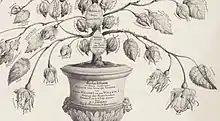Walburga of Egmont
Walburga[1] of Egmont (29 October 1490 – 7 March 1529) was countess of Nassau-Dillenburg, the first wife of William I, Count of Nassau-Dillenburg.
Walburga of Egmont | |
|---|---|
| Countess of Nassau-Dillenburg | |
 Walburga of Egmont in the tree of the House of Orange-Nassau, ca. 1813-1844 | |
| Born | 29 October 1490 |
| Died | 7 March 1529 (aged 38) Siegen |
| Noble family | Egmond, Nassau |
| Spouse(s) | Elisabeth Magdalene |
| Father | John III of Egmont |
| Mother | Magdalena Werdenberg-Heiligenberg |
She was the eldest daughter of John III of Egmont (1438–1516) from the House of Egmond and Magdalena Werdenberg-Heiligenberg (1464-1538) from the House of Werdenberg-Heiligenberg. She was most likely named after her grandmother Walburga of Meurs (c. 1415–1459), the mother of John III.
In 1506 at the age 16 Walburga married William I, Count of Nassau-Dillenburg in Koblenz, Germany on the 29th of October.[2] They settled down in Dillenburg Castle, where she gave birth to two daughters. On 7 March 1529 she died at age 39 at Siegen, Germany.
Children
Walburga gave birth to two daughters:[3]
- Elisabeth ( October 1520 – 31 January 1523)
- Magdalene ( 6 October 1522 – 18 August 1567), married on 16 July 1538 to Count Herman of Neuenahr and Moers[4]
References
- In books the given name is also written as Walburg, Walburge, Walpurg, Walpurga and Walpurgis.
- Jeroen Punt, Louis Sloos. Willem van Oranje: De jonge prins als edelman & militair. Amsterdam University Press, 2020. p. 37
- P.J. Schipperus in his 2018 book Philips Willem: de verloren zoon van Willem van Oranje claimed Willem I and Walburga had five children. Jan J.B. Kuipers in his 2020 book Willem van Oranje: Prins in Opstand doesn't acknowledge this claim, but confirms that there were only two.
- "Hermann , Graf zu Neuenahr und Mörs," in: Urkundenbuch für die Geschichte des Niederrheins oder des Erzstifts Cöln, der Fürstenthümer Jülich und Berg, Geldern, Meurs, Cleve und Mark, und der Reichsstifte Elten, Essen und Werden: aus den Quellen erläutert, Volume 4, 1858. p. 706.
This article is issued from Wikipedia. The text is licensed under Creative Commons - Attribution - Sharealike. Additional terms may apply for the media files.